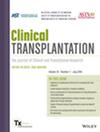Increasing Multiorgan Heart Transplantations From Donation After Circulatory Death Donors in the United States
Abstract
Introduction
Donation after circulatory death (DCD) donors are becoming an important source of organs for heart-transplantation (HT), but there are limited data regarding their use in multiorgan-HT.
Methods
Between January 2020 and June 2023, we identified 87 adult multiorgan-HTs performed using DCD-donors [77 heart–kidney, 6 heart–lung, 4 heart–liver] and 1494 multiorgan-HTs using donation after brain death (DBD) donors (1141 heart–kidney, 165 heart–lung, 188 heart–liver) in UNOS. For heart–kidney transplantations (the most common multiorgan-HT combination from DCD-donors), we also compared donor/recipient characteristics, and early outcomes, including 6-month mortality using Kaplan–Meier (KM) and Cox hazards-ratio (Cox-HR).
Results
Use of DCD-donors for multiorgan-HTs in the United States increased from 1% in January to June 2020 to 12% in January–June 2023 (p < 0.001); but there was a wide variation across UNOS regions and center volumes. Compared to recipients of DBD heart–kidney transplantations, recipients of DCD heart–kidney transplantations were less likely to be of UNOS Status 1/2 at transplant (35.06% vs. 69.59%) and had lower inotrope use (22.08% vs. 43.30%), lower IABP use (2.60% vs. 26.29%), but higher durable CF-LVAD use (19.48% vs. 12.97%), all p < 0.01. Compared to DBD-donors, DCD-donors used for heart–kidney transplantations were younger [28(22–34) vs. 32(25–39) years, p = 0.004]. Recipients of heart–kidney transplantations from DCD-donors and DBD-donors had similar 6-month survival using both KM analysis, and unadjusted and adjusted Cox-HR models, including in propensity matched cohorts. Rates of PGF and in-hospital outcomes were also similar.
Conclusions
Use of DCD-donors for multiorgan-HTs has increased rapidly in the United States and early outcomes of DCD heart–kidney transplantations are promising.

 求助内容:
求助内容: 应助结果提醒方式:
应助结果提醒方式:


